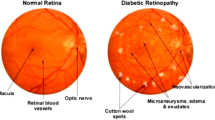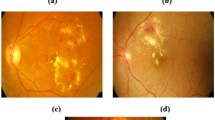Abstract
Till now, the detection of diabetic retinopathy seems to be one of the sensitive research topics since it is related to health care of any individual. A number of contributions in terms of detection already exists in the dice; still, there present some problems regarding the detection accuracy. This issue motivates to develop a new detection model of diabetic retinopathy, and moreover, this model tells the severity of retinopathy from the given fundus image. The proposed model includes preprocessing, segmentation, feature extraction and classification stages. Here, Triplet Half band Filterbank (THFB) Segmentation is performed, local vector pattern (LVP) is used for extracting the features, principle component analysis (PCA) procedure is used to reduce the dimensions of the feature vector, and neural network (NN) is used for classification purpose. The proposed model compares its performance over other conventional classifiers like support vector machine (SVM), k nearest neighbor (k-NN) and Navies Bayes (NB) in terms of positive and negative measures. The positive measures are accuracy, specificity, sensitivity, precision, negative predictive value (NPV), F1-Score and Matthews Correlation Coefficient (MCC). Similarly, the negative measures are the false positive rate (FPR), false negative rate (FNR) and false discovery rate (FDR), and the efficiency of the proposed model is proven.




Similar content being viewed by others
References
Cheung N, Mitchell P, Wong TY (2010) Diabetic retinopathy. Lancet 376(9735):124–36
Yau JWY et al (2012) Global prevalence and major risk factors of diabetic retinopathy. Diabetes Care 35(3):556–564
Niemeijer M, Abramoff MD, Ginneken BV (2009) Information fusion for diabetic retinopathy CAD in digital color fundus photographs. IEEE Trans Med Imaging 28(5):775–785
Agurto C et al (2010) Multiscale AM–FM methods for diabetic retinopathy lesion detection. IEEE Trans Med Imaging 29(2):502–512
Quellec G et al (2012) A multiple-instance learning framework for diabetic retinopathy screening. Med Image Anal 16(6):1228–1240
Molven A, Ringdal M, Nordbø AM, Raeder H, Støy J, Lipkind GM, Steiner DF, Philipson LH, Bergmann I, Aarskog D, Undlien DE, Joner G, Søvik O; Norwegian Childhood Diabetes Study Group, Bell GI, Njølstad PR (2008) Mutations in the insulin gene can cause MODY and autoantibody-negative type 1 diabetes., Diabetes 57(4):1131–1135
Seoud L, Hurtut T, Chelbi J, Cheriet F, Langlois JMP (April 2016) Red lesion detection using dynamic shape features for diabetic retinopathy screening. IEEE Trans Med Imaging 35(4):1116–1126
Osareh A, Shadgar B, Markham R (2009) A computational-intelligence-based approach for detection of exudates in diabetic retinopathy images. IEEE Trans Inf Technol Biomed 13(4):535–545
Zhang B, Wu X, You J, Li Q, Karray F (2010) Detection of microaneurysms using multi-scale correlation coefficients. Pattern Recognit 43(6):2237–2248
Lazar I, Hajdu A (2013) Retinal microaneurysm detection through local rotating cross-section profile analysis. IEEE Trans Med Imaging 32(2):400–407
Antal B, Hajdu A (2012) Improving microaneurysm detection using an optimally selected subset of candidate extractors and preprocessing methods. Pattern Recognit 45(1):264–270
Ranamuka NG, Meegama RGN (March 2013) Detection of hard exudates from diabetic retinopathy images using fuzzy logic. IET Image Proc 7(2):121–130
Amin J, Sharif M, Yasmin M, Ali H, Fernandes SL (2017) A method for the detection and classification of diabetic retinopathy using structural predictors of bright lesions. J Comput Sci 19:153–164
Sanchez CI, Niemeijer M, Dumitrescu AV, Suttorp-Schulten MSA, Abr`amoff MD, van Ginneken B (2011) Evaluation of a computer-aided diagnosis system for diabetic retinopathy screening on public data. Investig Ophthalmol Visual Sci 52(7):4866–4871
Odstrcilik J et al (2013) Retinal vessel segmentation by improved matched filtering: evaluation on a new high-resolution fundus image database. IET Image Proc 7(4):373–383
Trucco E et al (2013) Validating retinal fundus image analysis algorithms: issues and a proposal. Investig Ophthalmol Vis Sci 54(5):3546–3559
Zhang X, Thibault G, Decencière E, Marcotegui B, Laÿ B, Danno R, Cazuguel G, Quelle G, Lamard M, Massin P, Chabouis A, Victor Z, Ergina A (2014) Exudate detection in color retinal images for mass screening of diabetic retinopathy. Medical Image Anal 18(7):1026–1043
Decenci`ere E et al (2014) Feedback on a publicly distributed image database: the Messidor database. Image Anal Stereol 33:231–234
Niemeijer M et al (2010) Retinopathy online challenge: automatic detection of microaneurysms in digital color fundus photographs. IEEE Trans Med Imaging 29(1):185–195
Mendonc¸a AM, Sousa A, Mendonc¸a L, Campilho A (2013) Automatic localization of the optic disc by combining vascular and intensity information. Comput Med Imaging Graph 37(5–6):409–417
Akram MU, Khan A, Iqbal K, Butt WH (2010) Retinal image: optic disk localization and detection. In: Campilho A, Kamel M (eds) Image analysis and recognition, vol 6112. Springer, Berlin, Heidelberg, pp 40–49
Walter T, Klein JC, Massin P, Erginay A (Oct. 2002) A contribution of image processing to the diagnosis of diabetic retinopathy-detection of exudates in color fundus images of the human retina. IEEE Trans Med Imaging 21(10):1236–1243
Zhang B, Vijaya Kumar BVK, Zhang D (Feb. 2014) Detecting diabetes mellitus and nonproliferative diabetic retinopathy using tongue color, texture, and geometry features. IEEE Trans Biomed Eng 61(2):491–501
Ram K, Joshi GD, Sivaswamy J (2011) A successive clutter-rejection-based approach for early detection of diabetic retinopathy. IEEE Trans Biomed Eng 58(3):664–673
Usman M, Akram, Shoab A, Khan (2017) Automated detection of dark and bright lesions in retinal images for early detection of diabetic retinopathy. J Med Syst 36(5):3151–3162
Amol D, Rahulkar, Raghunath S, Holambe (2012) Half-Iris feature extraction and recognition using a new class of biorthogonal triplet half-band filter bank and flexible k-out-of-n:A postclassifier. IEEE Trans Inf Forensics Secur 7(1):230–240
Hung TY, Fan KC (2014) Local vector pattern in high-order derivative space for face recognition. In: 2014 ieee international conference on image processing (ICIP), Paris, pp. 239–243
Han Y, Feng X-C, Baciu G. (2013) Variational and PCA based natural image segmentation. Pattern Recognit 46(7):1971–1984
Mohan Y, Chee SS, Xin DKP, Foong LP (2016) Artificial neural network for classification of depressive and normal in EEG. In: 2016 IEEE EMBS conference on biomedical engineering and sciences (IECBES)
Kaur R, Kaur S (2016) Comparison of contrast enhancement techniques for medical image. In: 2016 conference on emerging devices and systems (ICEDSS), Namakkal, pp. 155–159
Meyer D, Leisch F, Hornik K (2003) The support vector machine under test. Neurocomputing 55(1–2):169–186
Sugumaran V, Muralidharan V (2012) A comparative study of Naïve Bayes classifier and Bayes net classifier for fault diagnosis of monoblock centrifugal pump using wavelet analysis. Appl Soft Comput 12(8):2023–2029
Wu Y, Ianakiev K, Govindaraju V (2002) Improved k-nearest neighbor classification. Pattern Recogn 35(10):2311–2318
Naït-Ali A, Adam O, Motsch JF (2000) Modelling and recognition of brainstem auditory evoked potentials using Symlet wavelet. ITBM-RBM 21(3):150–157
Lina J-M, Mayrand M (1995) Complex Daubechies wavelets. Appl Comput Harmonic Anal 2(3):219–229,
Winger LL, Venetsanopoulos AN (2001) Biorthogonal nearly coiflet wavelets for image compression. Sig Process Image Commun 16(9)859–869
Prasad PMK, Prasad DYV, Rao GS (2016) Performance analysis of orthogonal and biorthogonal wavelets for edge detection of X-ray images. Proc Comput Sci 87:116–121
Kumar BSS, Manjunath AS, Christopher S (2018) Improved entropy encoding for high efficient video coding standard. Alex Eng J 57(1):1–9
Kota PN, Gaikwad AN (2017) Optimized scrambling sequence to reduce Papr in space frequency block codes based MIMO-OFDM system. J Adv Res Dyn Control Syst 502–525
Bhatnagar K, Gupta SC (2017) Extending the neural model to study the impact of effective area of optical fiber on laser intensity. Int J Intell Eng Syst 10(4):274–283
Balaji GN, Subashini TS, Chidambaram N (2015) Detection of heart muscle damage from automated analysis of echocardiogram video. IETE J Res 61(3):236–243
Bramhe SS, Dalal A, Tajne D, Marotkar D (2015) Glass shaped antenna with defected ground structure for cognitive radio application. In: International conference on computing communication control and automation, Pune, pp. 330–333
Yarrapragada KSSR, Krishna BB (2017) Impact of tamanu oil-diesel blend on combustion, performance and emissions of diesel engine and its prediction methodology. J Braz Soc Mech Sci Eng 39:1797–1811
Sreedharan NPN, Ganesan B, Raveendran R, Sarala P, Dennis B, Rajakumar BR (2018) Grey Wolf optimisation-based feature selection and classification for facial emotion recognition. IET Biom. https://doi.org/10.1049/iet-bmt.2017.0160
Sarkar A, Murugan TS (2017) Cluster head selection for energy efficient and delay-less routing in wireless sensor network. Wirel Netw. https://doi.org/10.1007/s11276-017-1558-2
Wagh AM, Todmal SR (2015) Eyelids, eyelashes detection algorithm and hough transform method for noise removal in iris recognition. Int J Comput Appl 112(3):28–31
Iyapparaja M, Tiwari M (2017) Security policy speculation of user uploaded images on content sharing sites. IOP Conf Ser Mater Sci Eng 263(4):042019
Sopharak A, Uyyanonvara B, Barman S (2013) Simple hybrid method for fine microaneurysm detection from not-dilated diabetic retinopathy retinal images. Comput Med Imaging Graph 37(5–6):394–402
Mookiah MRK, Rajendra Acharya U, Martis RJ, Chua CK, Lim CM, Ng EYK, Laude A (2013) Evolutionary algorithm based classifier parameter tuning for automatic diabetic retinopathy grading: a hybrid feature extraction approach. Knowl Based Syst 39:9–22
Welikala RA, Fraz MM, Dehmeshki J, Hoppe A, Tah V, Mann S, Williamson TH, Barman SA (2015) Genetic algorithm based feature selection combined with dual classification for the automated detection of proliferative diabetic retinopathy. Comput Med Imaging Graph 43:64–77
Quellec G, Lamard M, Josselin PM, Cazuguel G, Cochener B, Roux C (2008) Optimal wavelet transform for the detection of microaneurysms in retina photographs. IEEE Trans Med Imaging 27(9):1230–1241
Niemeijer M, Abramoff MD, van Ginneken B (2007) Segmentation of the optic disc, macula and vascular arch in fundus photographs. IEEE Trans Med Imaging 26(1):116–127
Salazar-Gonzalez A, Kaba D, Li Y, Liu X (2014) Segmentation of the blood vessels and optic disk in retinal images. IEEE J Biomed Health Inform 18(6):1874–1886
Kaur J, Mittal D (2018) A generalized method for the segmentation of exudates from pathological retinal fundus images. Biocybern Biomed Eng 38(1):27–53
Morales S, Engan K, Naranjo V, Colomer A (2017) Retinal disease screening through local binary patterns. IEEE J Biomed Health Inform 21(1):184–192
Galshetwar GM, Waghmare LM, Gonde AB, Murala S (2017) Edgy salient local binary patterns in inter-plane relationship for image retrieval in diabetic retinopathy. Proc Comput Sci 115:440–447
Abdillah B, Bustamam A, Sarwinda D (2017) Classification of diabetic retinopathy through texture features analysis. In: 2017 International conference on advanced computer science and information systems
Sarwinda D, Bustamam A, Arymurthy AM (2017) Fundus image texture features analysis in diabetic retinopathy diagnosis. In: 2017 eleventh international conference on sensing technology (ICST), Sydney, NSW, pp. 1–5
Acknowledgement
We acknowledged our sincere thanks to Dr. Amol D Rahulkar, National Institute of Technology, Goa and Pimpri Chinchwad Education Trust’s Pimpri Chichwad College of Engineering & Research, Ravet, Pune for their encouragement and valuable support during this research work.
Author information
Authors and Affiliations
Corresponding author
Additional information
Publisher’s Note
Springer Nature remains neutral with regard to jurisdictional claims in published maps and institutional affiliations.
Rights and permissions
About this article
Cite this article
Randive, S.N., Rahulkar, A.D. & Senapati, R.K. LVP extraction and triplet-based segmentation for diabetic retinopathy recognition. Evol. Intel. 11, 117–129 (2018). https://doi.org/10.1007/s12065-018-0158-0
Received:
Revised:
Accepted:
Published:
Issue Date:
DOI: https://doi.org/10.1007/s12065-018-0158-0




